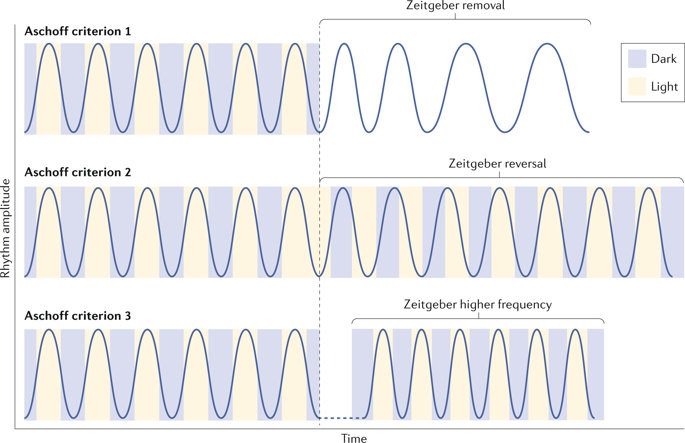当前位置:
X-MOL 学术
›
Nat. Rev. Endocrinol.
›
论文详情
Our official English website, www.x-mol.net, welcomes your
feedback! (Note: you will need to create a separate account there.)
Food as a circadian time cue - evidence from human studies.
Nature Reviews Endocrinology ( IF 31.0 ) Pub Date : 2020-02-13 , DOI: 10.1038/s41574-020-0318-z Philip Lewis 1 , Henrik Oster 2 , Horst W Korf 3 , Russell G Foster 4 , Thomas C Erren 1
Nature Reviews Endocrinology ( IF 31.0 ) Pub Date : 2020-02-13 , DOI: 10.1038/s41574-020-0318-z Philip Lewis 1 , Henrik Oster 2 , Horst W Korf 3 , Russell G Foster 4 , Thomas C Erren 1
Affiliation

|
Meal timing and composition are frequently reported in the literature as zeitgebers (that is, time cues) for the circadian system of humans and animal models, albeit secondary to light. Although widely assumed to be true, evidence for food zeitgeber effects specific to humans is notably scarce. Fostering zeitgeber hygiene in the general population as the development and practice of healthy use of zeitgebers could potentially reduce chronobiological strain, which is defined as disruption or misalignment within the circadian system. Such chronobiological strain is associated with modern 24/7 lifestyles (for example, shift work) and several negative health outcomes. Adjustments to meal timing and composition are an attractive strategy to synchronize circadian rhythms and develop zeitgeber hygiene. Thus, clarifying the actual effect of meal timing and composition on the human circadian system is a crucial piece of the human chronobiology puzzle. This Review weighs the evidence from human studies pertaining to the hypothesis that food is a circadian zeitgeber by comparing findings against formal zeitgeber criteria put forward by Jürgen Aschoff in the 1950s.
中文翻译:

食物作为昼夜节律时间线索 - 来自人类研究的证据。
膳食时间和组成在文献中经常被报道为人类和动物模型的昼夜节律系统的 zeitgebers(即时间线索),尽管次要于光。尽管人们普遍认为这是正确的,但人类特有的食物时代效应的证据却非常稀缺。在普通人群中培养 zeitgeber 卫生,因为 zeitgeber 的健康使用的发展和实践可能会减少时间生物学压力,这被定义为昼夜节律系统内的破坏或错位。这种时间生物学菌株与现代 24/7 生活方式(例如,轮班工作)和一些负面的健康结果有关。调整进餐时间和组成是同步昼夜节律和发展时代卫生的有吸引力的策略。因此,阐明进餐时间和组成对人类昼夜节律系统的实际影响是人类时间生物学难题的关键部分。这篇评论通过将研究结果与 Jürgen Aschoff 在 1950 年代提出的正式时代标准进行比较,权衡了与食物是昼夜节律假设有关的人类研究证据。
更新日期:2020-02-13
中文翻译:

食物作为昼夜节律时间线索 - 来自人类研究的证据。
膳食时间和组成在文献中经常被报道为人类和动物模型的昼夜节律系统的 zeitgebers(即时间线索),尽管次要于光。尽管人们普遍认为这是正确的,但人类特有的食物时代效应的证据却非常稀缺。在普通人群中培养 zeitgeber 卫生,因为 zeitgeber 的健康使用的发展和实践可能会减少时间生物学压力,这被定义为昼夜节律系统内的破坏或错位。这种时间生物学菌株与现代 24/7 生活方式(例如,轮班工作)和一些负面的健康结果有关。调整进餐时间和组成是同步昼夜节律和发展时代卫生的有吸引力的策略。因此,阐明进餐时间和组成对人类昼夜节律系统的实际影响是人类时间生物学难题的关键部分。这篇评论通过将研究结果与 Jürgen Aschoff 在 1950 年代提出的正式时代标准进行比较,权衡了与食物是昼夜节律假设有关的人类研究证据。







































 京公网安备 11010802027423号
京公网安备 11010802027423号